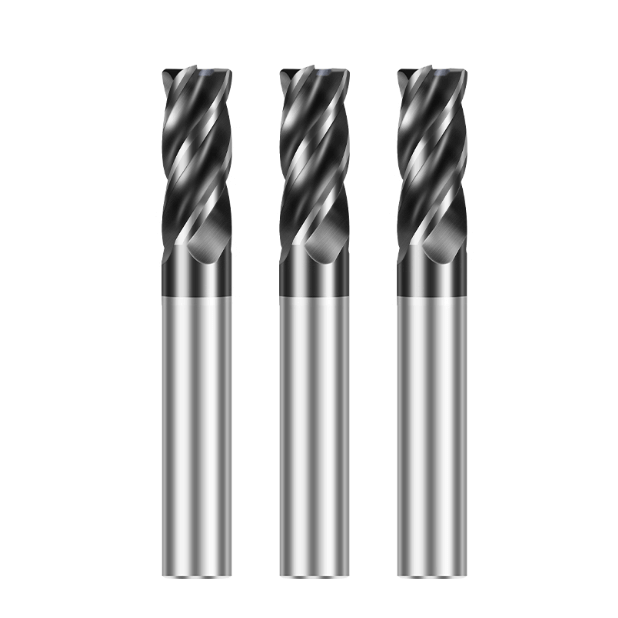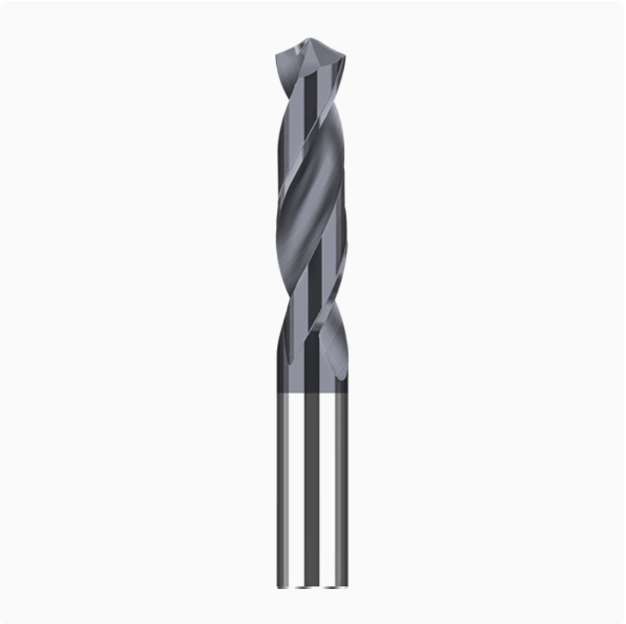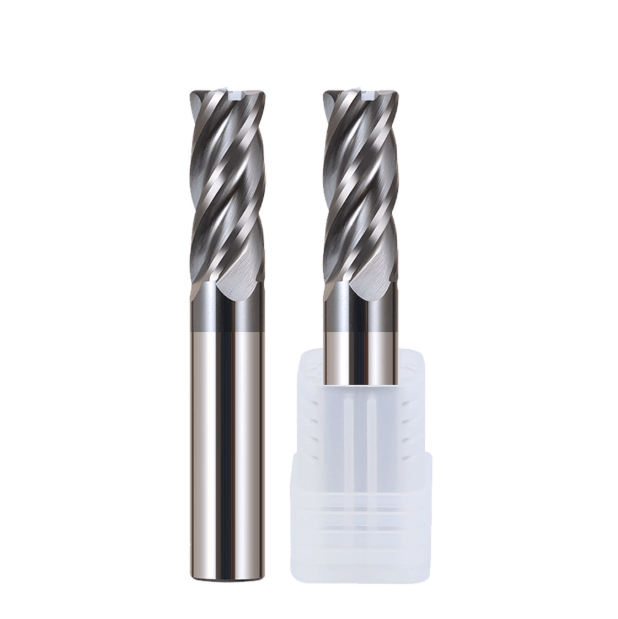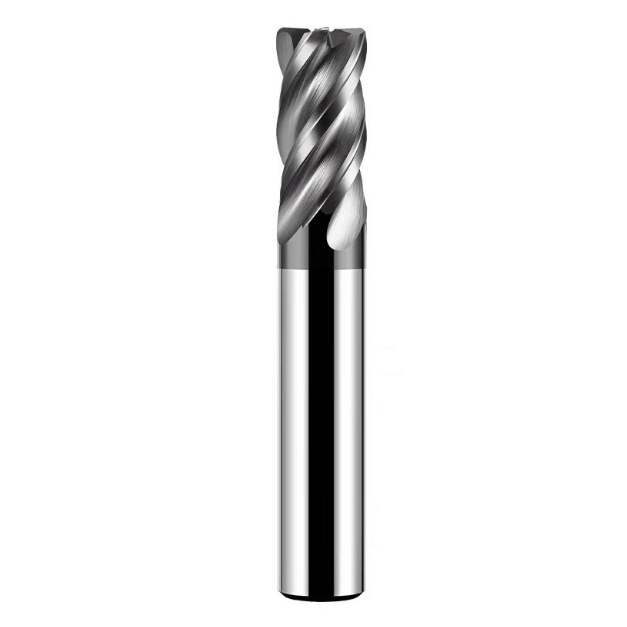Although CNC end milling is a core process in precision part manufacturing, it often encounters challenges such as tool chipping, excessive wear, cutting vibration, and unstable surface finish. Different types of end milling bits play distinct roles in solving these problems. For instance, solid carbide end milling bits, known for their high hardness and wear resistance, ensure longer tool life under heavy loads. Roughing end milling bits excel in large-volume material removal, while finishing end milling bits provide superior surface finishes but require more stable machines and optimized parameters.
When machining hardened materials, such as using end milling bits for hardened steel, choosing the right tool geometry and cutting parameters is crucial to control heat generation and extend tool life. For complex geometries or specialized requirements, custom end milling bits for CNC can outperform standard tools by improving dimensional precision and surface consistency.
This article systematically analyzes common CNC end milling problems and provides practical solutions involving cutting parameter optimization, tool material selection, process adjustments, and preventive maintenance strategies. These insights aim to help engineers maintain machining efficiency while extending tool life and improving part quality.
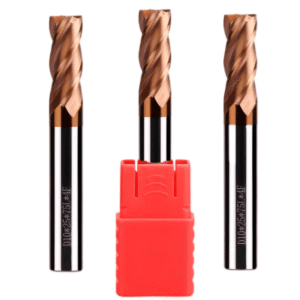
Overview of Common Machining Problems and Influencing Factors
In CNC end milling, tool performance and process parameters directly determine surface finish, dimensional accuracy, and machining efficiency. Common machining issues not only affect surface precision but also shorten tool life and increase overall costs.
Different types of end milling bits behave differently under high-load or high-hardness conditions. For example, solid carbide end milling bits, despite their rigidity, may still experience chipping when feed or speed settings are unstable. Roughing end milling bits can suffer from excessive vibration during heavy cutting, while finishing end milling bits demand high spindle stability and precise control to achieve consistent surface finish.
Key influencing factors include tool clamping accuracy, toolholder concentricity, tool geometry, cutting parameters, workpiece material hardness, and cooling/lubrication conditions. Systematic optimization of these elements can significantly reduce machining defects, improve productivity, and extend tool life.
Surface Marking Caused by Machining Vibration and Tool Runout
Tool vibration or eccentric runout often leads to surface waviness and inconsistent roughness. During high-speed or high-feed cutting, unstable tool–workpiece contact causes periodic surface markings. Major contributors include insufficient machine rigidity, inaccurate toolholder concentricity, or poor tool balance.
Using solid carbide end milling bits or custom end milling bits for CNC with optimized geometries can effectively enhance tool rigidity, reduce vibration amplitude, and achieve smoother surface finishes, especially in finishing operations.
Tool Chipping, Excessive Wear, and Short Tool Life
Tool chipping and premature wear are among the most frequent problems in CNC production. They are typically caused by excessive feed rates, improper depth of cut, or material hardness exceeding the tool’s limit. Insufficient cooling also accelerates edge wear.
When machining hardened steels, choosing end milling bits for hardened steel and optimizing cutting parameters is essential. Selecting solid carbide end milling bits, ensuring proper lubrication, and maintaining suitable cutting conditions can significantly extend tool life, reduce downtime, and maintain machining consistency.
Cutting Built-up Edge and Material Sticking
When machining soft and adhesive materials like aluminum, copper, or titanium alloys, built-up edges (BUE) can form on the cutting edge. This alters the effective cutting geometry, accelerates wear, and deteriorates surface finish.
Using high-speed, sharp-edged tools, such as finishing end milling bits, along with adequate coolant and chip evacuation, helps minimize BUE formation. Adjusting cutting speed and feed to maintain stable chip flow ensures cleaner surfaces and consistent tool performance.
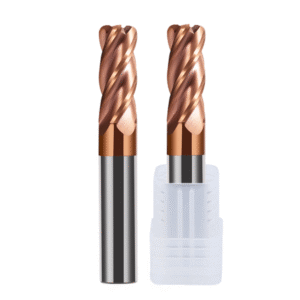
Typical Problems and Optimization Strategies for Different Tool Types
Each tool type presents unique challenges depending on the machining scenario. Roughing end milling bits handle large material removal but are prone to chip blockage and vibration. Finishing end milling bits focus on dimensional precision and surface finish, demanding higher cutting accuracy. In contrast, end milling bits for hardened steel must withstand high cutting loads and elevated temperatures.
By optimizing tool geometry, coating technology, and machining parameters, manufacturers can effectively reduce tool wear, improve surface integrity, and enhance overall productivity.
Common Problems and Solutions for Roughing End Milling Bits
During high-load roughing, issues such as tool breakage, poor chip evacuation, and excessive vibration frequently occur. The main causes include excessive depth of cut, insufficient flute space, or an unsuitable helix angle.
Optimization strategies include:
-
Refining tool geometry: Increasing the helix angle or using wavy-edge designs improves chip evacuation and reduces vibration.
-
Choosing appropriate materials and coatings: Use wear-resistant solid carbide end milling bits to maintain strength and integrity under heavy loads.
-
Adjusting cutting parameters: Reduce feed rate and depth of cut to balance cutting forces and extend tool life.
These improvements help maintain roughing efficiency and ensure smoother transitions to finishing stages.
Surface Finish Issues with Finishing End Milling Bits
During finishing operations, even minor tool or parameter inconsistencies can lead to burrs, uneven surfaces, or microcracks. The root causes often include dull edges, tool vibration, or improper cutting speeds.
Optimization strategies include:
-
Using high-precision finishing end milling bits with sharp edges or advanced coatings.
-
Improving machine stability and fixture rigidity.
-
Adjusting cutting parameters based on material hardness and tool diameter to achieve optimal surface finish.
With these adjustments, finishing operations can achieve consistent surface quality, reduced rework, and greater dimensional control.
Tool Damage and Thermal Cracking in Hard Material Machining (HRC60+)
When machining steels above HRC60, end milling bits for hardened steel often face extreme thermal loads that cause edge chipping and cracking.
Key countermeasures:
-
Select appropriate tool material: Use solid carbide end milling bits with high heat resistance.
-
Apply high-performance coatings: TiAlN or AlCrN coatings reduce oxidation and heat stress.
-
Optimize cutting parameters: Lower cutting speed and use efficient coolant systems to control temperature and prevent thermal shock.
These adjustments enhance machining stability, prolong tool life, and maintain surface precision when processing hardened materials.
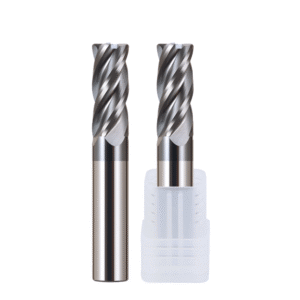
Optimizing the Matching of Materials and Tool Structures
In CNC end milling, the tool material and structural design play a decisive role in machining efficiency, tool life, and surface finish quality. Different workpiece materials require end milling bits with specific hardness, wear resistance, edge geometry, and coating performance. By properly matching the tool material, cutting geometry, and coating technology, machinists can significantly improve cutting stability, reduce tool chipping and wear, and achieve higher machining accuracy.
When dealing with hard-to-machine materials or complex part geometries, selecting suitable solid carbide end milling bits or custom CNC end milling bits provides a more reliable solution. These tools can handle higher cutting forces, maintain edge sharpness, and deliver a consistent surface finish even under demanding machining conditions. Proper tool-material matching not only enhances productivity but also extends tool life and reduces overall machining costs.
Performance Characteristics and Applications of Solid Carbide End Milling Bits
Solid carbide end milling bits are well known for their exceptional hardness, high wear resistance, and superior thermal stability, making them ideal for precision machining and high-hardness materials. Compared with traditional high-speed steel (HSS) tools, carbide end mills can withstand greater cutting loads, minimize vibration, extend tool life, and maintain excellent dimensional accuracy throughout long production runs.
Typical applications include:
-
Machining high-hardness steels (HRC55 and above) to prevent edge chipping and ensure dimensional consistency;
-
Producing high-precision molds, achieving superior surface finish and geometric accuracy;
-
Cutting complex 3D surfaces or small-diameter parts, where tool rigidity and geometric precision ensure smooth and stable cutting.
By combining the advantages of roughing end milling bits for heavy material removal with finishing end milling bits for accuracy, manufacturers can achieve both high material removal rates and refined surface finishes in a single workflow.
Key Points for Selecting Tool Geometry and Coatings for Different Materials
Different machining materials demand specific combinations of tool geometry and coating technology to achieve stable cutting and extended tool life. Below are several key recommendations:
-
Soft metals (aluminum, copper): Require sharp cutting edges and large helix angles to ensure smooth chip evacuation. Anti-stick coatings such as TiB₂ help reduce built-up edge (BUE) and enhance cutting performance.
-
Stainless steel and titanium alloys: Need rigid tools with smaller rake angles and heat-resistant coatings like AlTiN or TiAlN to prevent premature wear and maintain surface finish quality.
-
Hardened steel: Use dedicated end milling bits for hardened steel made from carbide with high-temperature-resistant coatings to reduce thermal cracking, edge chipping, and tool fatigue.
-
Composite materials (carbon fiber, fiberglass): Require sharp cutting edges with fewer flutes and smooth chip evacuation to minimize delamination and fiber pull-out.
By carefully matching material characteristics with the right tool geometry, coating, and material composition, manufacturers can extend the service life of solid carbide end milling bits, improve machining stability, and ensure superior surface finish across a wide range of CNC machining applications.
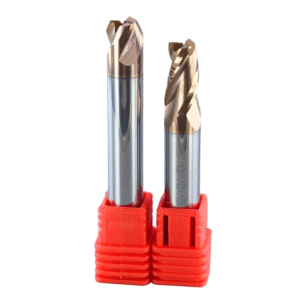
Machining Parameter and Process Adjustment Recommendations
In CNC end milling, even with high-quality end milling bits and optimized tool geometry, the cutting parameters and process design remain decisive factors affecting machining efficiency, tool life, and surface finish. Proper control of cutting speed, feed rate, toolpath strategy, and cutting direction can dramatically reduce tool wear and vibration while ensuring stable cutting performance across various materials — including with solid carbide end milling bits, roughing end mills, finishing end mills, and end mills for hardened steel.
Equally important are cooling and lubrication strategies, which directly influence cutting temperature, chip evacuation, and dimensional accuracy, especially when machining hardened steels or high-temperature alloys. Scientifically designed machining parameters and optimized processes not only boost efficiency but also extend tool life and reduce machining defects, providing reliable support for complex part manufacturing using custom end mills for CNC.
Balancing Cutting Speed, Feed Rate, and Tool Life
Cutting speed and feed rate have a direct impact on tool wear, cutting temperature, and surface quality. Excessively high speeds may cause thermal cracking or edge chipping on solid carbide end mills, while too low speeds reduce productivity. Similarly, excessive feed rates increase cutting load and vibration, accelerating wear and reducing surface finish quality.
To balance tool life and machining efficiency, consider the following strategies:
-
Adjust cutting speed and feed rate according to material hardness and tool diameter.
-
During roughing, prioritize material removal efficiency with roughing end mills, allowing a higher feed rate.
-
During finishing, reduce feed rate and cutting depth when using finishing end mills to ensure surface finish and dimensional precision.
Maintaining the correct balance between speed and feed rate is key to prolonging tool life and achieving consistent, high-quality results.
The Role of Cooling and Lubrication in Cutting Stability
Effective cooling and lubrication are critical for controlling cutting temperatures, minimizing tool wear, and improving chip evacuation. Depending on the machining scenario, dry or wet cutting can be selected:
-
Dry cutting: Ideal for light-load machining or non-hardened materials using carbide end mills, offering cleaner operations with reduced fluid handling.
-
Wet cutting or high-pressure coolant: Recommended for high-load or hardened steel machining, providing superior heat dissipation, preventing thermal cracking, and extending tool life.
Additionally, optimizing coolant flow rate and injection angle—combined with the rigidity of solid carbide end milling bits—enhances cutting stability, chip evacuation, and overall surface accuracy.
Toolpath Strategy and Cutting Direction Optimization
Toolpath strategy and cutting direction directly influence machining stability and surface quality. Choosing between climb milling and conventional milling depends on the material, tool type, and machine rigidity:
-
Climb milling: Offers smoother tool engagement and less vibration, ideal for finishing end mills to achieve superior surface finish.
-
Conventional milling: Suitable for certain hard materials or roughing operations, though it may produce more burrs.
By optimizing toolpath design, cutting direction, and custom end mill geometry, machinists can minimize tool wear, improve chip flow, and achieve high-precision machining for complex parts.
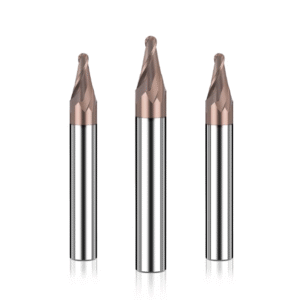
Advantages of Customized Tools in Complex Machining
For complex geometries and high-precision components, standard end mills often cannot meet the demands of advanced materials or tight tolerances. In these cases, custom end mill bits for CNC offer distinct advantages. Custom tools can be designed with optimized geometry, flute count, helix angle, and coating type, tailored to the specific workpiece material and cutting conditions.
Such customization enhances tool rigidity, wear resistance, and cutting efficiency, while ensuring consistent surface quality. These advantages make custom end mills ideal for mold machining, 3D surface milling, aerospace components, and composite materials machining.
Design Principles and Case Studies for Custom End Mills
The design of custom CNC end milling bits typically follows several engineering principles:
-
Optimized tool geometry: Select cutting edge radius, rake angle, and helix angle based on workpiece shape to reduce cutting forces and vibration.
-
Tool material and coating selection: Choose solid carbide end mills with advanced coatings (e.g., TiAlN, AlCrN) for specific materials like hardened steel, titanium alloy, or composites to enhance durability.
-
Flute count and chip evacuation design: Adjust the number and shape of flutes to improve chip flow and prevent clogging during high-load operations.
For example, in aerospace 3D surface machining, custom tools with optimized helix angles and nose radii enable seamless transitions between roughing and finishing, maintaining dimensional accuracy and surface integrity on complex contours.
Custom Tool Applications for Specialized Machining Challenges
Customized tools excel where standard tools struggle, such as:
-
Complex surface machining: Adjusting edge radius and tool length minimizes vibration and interference.
-
High-hardness material machining: Reinforced tool cores and optimized geometry improve thermal stability and resistance to chipping when machining end mills for hardened steel.
-
Thin-wall or precision part machining: Reducing radial forces prevents deformation and vibration, achieving ultra-precise results.
Through these targeted designs, custom end mills for CNC effectively solve machining challenges related to special materials, intricate geometries, and precision requirements—providing a stable and efficient tooling solution.
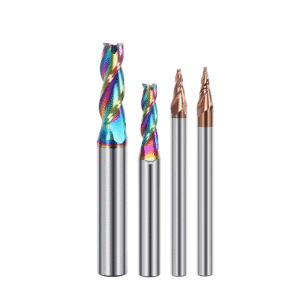
Maintenance and Preventive Measures
Even with high-quality solid carbide end milling bits or custom end milling bits for CNC, improper maintenance and lack of preventive management can lead to premature tool wear, chipping, and performance degradation. Establishing a systematic tool maintenance and prevention strategy is therefore essential in CNC end milling. Regular inspection, proper storage, and cleaning management not only extend tool service life but also maintain machining stability, minimize production downtime, and ensure consistent results for both roughing and finishing end milling bits.
Tool Wear Monitoring and Regrinding Cycle Management
Tool wear is one of the most critical factors affecting machining accuracy and tool longevity. Advanced tool inspection systems or visual monitoring can help detect wear conditions in real time, such as cutting edge abrasion, chip buildup, and tool tip breakage. Scheduling timely regrinding or replacement of solid carbide end milling bits based on wear severity can effectively restore cutting performance, maintain surface quality, and ensure dimensional accuracy.
A well-structured regrinding cycle management system—considering machining materials, cutting parameters, and tool type—helps optimize tool utilization, reduce downtime from unexpected failures, and improve overall production efficiency.
The Importance of Proper Storage and Tool Cleaning
Tool storage conditions and cleanliness directly affect the lifespan and performance of end milling bits for hardened steel and other high-hardness or coated tools. Prolonged exposure to humid or dusty environments can cause corrosion or coating damage, reducing cutting precision and tool durability.
Key maintenance practices include:
-
Proper storage: Maintain controlled humidity and prevent tool contact with corrosive materials to keep cutting edges sharp.
-
Regular cleaning: Remove debris, oil, and cutting fluids from tool surfaces to prevent corrosion and chip buildup.
-
Protective management: Use dedicated toolboxes or holders for storing roughing, finishing, and custom end milling bits, preventing impact damage and edge deformation.
Through proper storage and cleaning management, the long-term stability and performance of custom end milling bits for CNC can be ensured, supporting reliable high-precision machining.
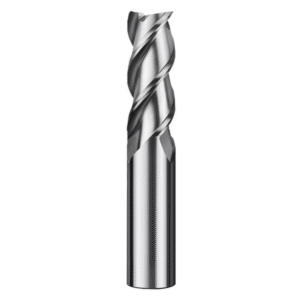
Achieving Efficient and Stable CNC Machining Through Proper Tool Selection and Optimization
Common issues in CNC end milling often arise from tool wear, unstable cutting performance, improper parameter settings, or poor matching of tool type and workpiece material. Each tool category—solid carbide end milling bits, roughing end milling bits, finishing end milling bits, end milling bits for hardened steel, and custom end milling bits for CNC—has specific strengths in addressing these challenges.
A comprehensive analysis of factors such as machining vibration, tool chipping, chip evacuation, toolpath design, and cooling and lubrication strategies can effectively guide tool selection and process optimization, improving machining efficiency and surface finish.
Selecting the proper tool material, geometry, and coating tailored to each workpiece not only minimizes chipping and thermal cracking during hard-material machining but also ensures dimensional precision and stable performance. In addition, scientifically designed cutting parameters, effective cooling strategies, optimized toolpaths, and preventive maintenance further extend tool life and maintain machining consistency.
In summary, efficient and stable CNC machining depends on the right combination of end milling bit selection, optimization, and customization. Whether for large-volume roughing, precision mold machining, complex 3D surfaces, or high-hardness materials, applying these strategies can significantly boost productivity, lower costs, and extend the tool life cycle—delivering reliable, high-performance solutions for modern manufacturing.




